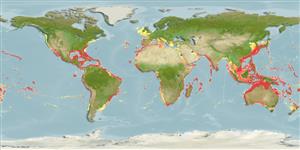Elasmobranchii (sharks and rays) >
Carcharhiniformes (Ground sharks) >
Carcharhinidae (Requiem sharks)
Etymology: Galeocerdo: Greek, galeos = a shark + latin, cerdus = the hard hairs of pigs (Ref. 45335).
Environment / Climate / Range
Ecology
Marine; brackish; benthopelagic; oceanodromous (Ref. 51243); depth range 0 - 800 m (Ref. 96339), usually 0 - 140 m (Ref. 26938). Subtropical, preferred 26°C (Ref. 107945); 62°N - 42°S, 180°W - 180°E
Circumglobal in tropical and temperate seas. Western Atlantic: Massachusetts, USA to Uruguay, including Gulf of Mexico and the Caribbean. Eastern Atlantic: Iceland to Angola. Indo-Pacific: Persian Gulf (Ref. 68964), Red Sea and East Africa to Hawaii and Tahiti, north to southern Japan, south to New Zealand. Eastern Pacific: southern California, USA to Peru, including the Revillagigedo, Cocos, and Galapagos islands. Highly migratory species, Annex I of the 1982 Convention on the Law of the Sea (Ref. 26139).
Length at first maturity / Size / Weight / Age
Maturity: Lm ?, range 210 - 350 cm
Max length : 750 cm TL male/unsexed; (Ref. 58784); common length : 500 cm TL male/unsexed; (Ref. 2683); max. published weight: 807.4 kg (Ref. 4699); max. reported age: 50 years (Ref. 4827)
Dorsal
spines
(total): 0;
Dorsal
soft rays
(total): 0;
Anal
spines: 0;
Anal
soft rays: 0. A huge, vertical tiger-striped shark with a broad, bluntly rounded snout, long upper labial furrows, and a big mouth with large, saw-edged, cockscomb-shaped teeth; spiracles present; caudal keels low (Ref. 5578). Grey above with vertical dark grey to black bars and spots which appear faded in adults, white below (Ref. 5578).
Usually found near surface to depths of 140 m (Ref. 26938); in Tahiti from 0-350m (Ref. 89972) . Occurs on or adjacent to continental and insular shelves, frequenting river estuaries, off wharves and jetties in harbors, and in coral atolls and lagoons (Ref. 244). Bottom-associated, sometimes pelagic (Ref. 58302). Also off oceanic islands far from other islands and continental land masses (Ref. 244). Makes excursions in the open ocean, but is not a truly oceanic species (Ref. 244). Nocturnal feeder on other sharks, rays, bony fishes, marine mammals, tortoises, seabirds, sea snakes, squids, gastropods, crustaceans, detritus (Ref. 9997), also including toxic or armored fish species such as Lactoria cornuta or Diodon hystrix, porpoises, whales, sea turtles, cephalopods, domestic animals and humans (Ref. 37816). It also feeds on carrion and garbage, including cans, pieces of metal and burlap bags (Ref. 26938). Second only to Carcharodon carcharias in recorded attacks on humans with at least 27 documented attacks sourced to it . One specimen, reportedly taken off Indo-China, weighed 3,110 kg and measured 740 cm (Ref. 9987). May be kept in an aquaria, but does not last for more than a few months (Ref. 244). Ovoviviparous (Ref. 50449). Up to 80 young of 51 to 104 cm are born per litter (Ref. 1602). Valued for its meat, fins, hide and liver oil (Ref. 9997) and also for its jaws and cartilage (Ref. 58048). Often used for fishmeal (Ref. 9997). Utilized fresh, dried-salted, smoked and frozen (Ref. 9987). Species from the Persian Gulf and Oman Sea has a max size of 750 cm TL (Ref. 47613).
Ovoviviparous (Ref. 4805, 6871) with 10-82 in a litter (Ref. 26346). Mating takes place even before gravid females have given birth (Ref. 244). Distinct pairing with embrace (Ref. 205). Gestation period: 13-16 months. Size at birth between 51 (Ref. 244) and 104 (Ref. 9997) cm TL; born at about 51-76 cm TL (Ref. 58048).
Compagno, L.J.V., 1984. FAO Species Catalogue. Vol. 4. Sharks of the world. An annotated and illustrated catalogue of shark species known to date. Part 2 - Carcharhiniformes. FAO Fish. Synop. 125(4/2):251-655. Rome: FAO. (Ref. 244)
IUCN Red List Status (Ref. 115185)
CITES (Ref. 94142)
Not Evaluated
Human uses
Fisheries: commercial; gamefish: yes
Tools
Special reports
Download XML
Internet sources
Estimates of some properties based on models
Phylogenetic diversity index (Ref.
82805): PD
50 = 1.0000 [Uniqueness, from 0.5 = low to 2.0 = high].
Bayesian length-weight: a=0.00380 (0.00245 - 0.00591), b=3.16 (3.03 - 3.29), in cm Total Length, based on LWR estimates for this species & (Sub)family-body (Ref.
93245).
Trophic Level (Ref.
69278): 4.5 ±0.0 se; Based on diet studies.
Resilience (Ref.
69278): Low, minimum population doubling time 4.5 - 14 years (tm=4-11; tmax=50; Fec = 10).
Prior r = 0.12, 2 SD range = 0.02 - 0.65, log(r) = -2.12, SD log(r) = 0.83, Based on: 2 K, 9 tgen, 1 tmax, 2 Fec records
Vulnerability (Ref.
59153): High vulnerability (64 of 100) .
